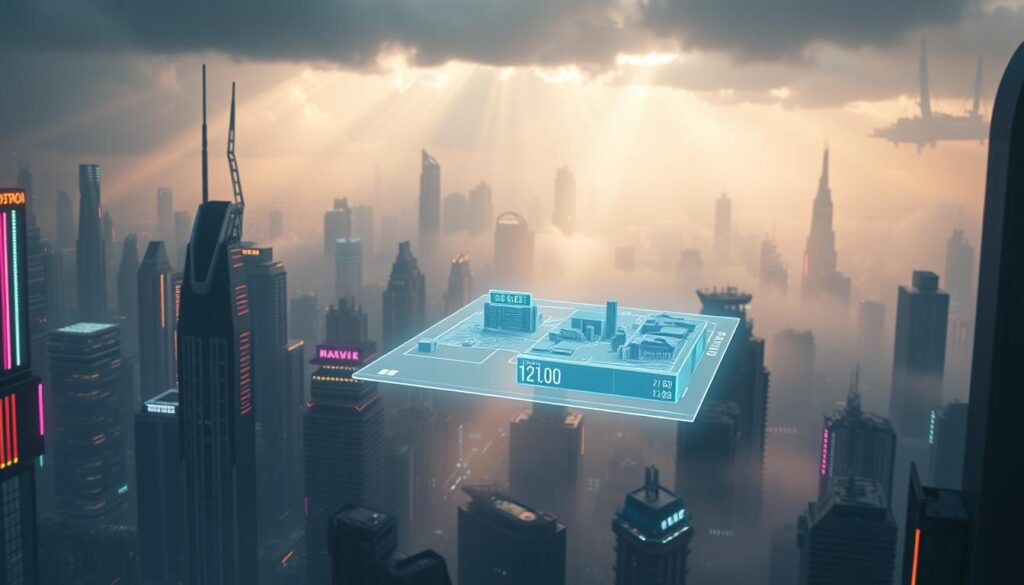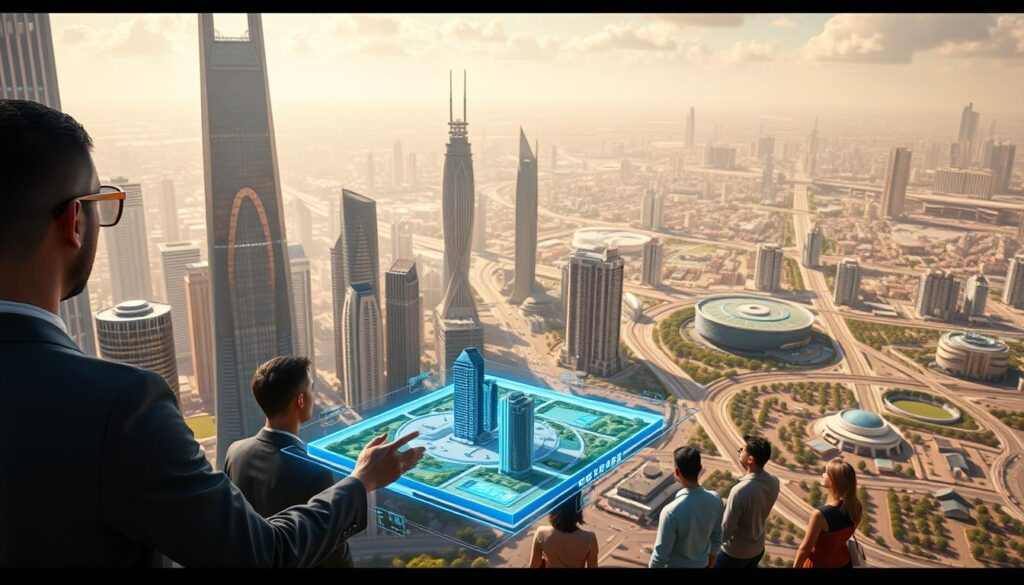We are stepping into the new world of the metaverse. Here, buying digital land is getting very real. Investing in metaverse property is more than just fun; it’s a fresh way to make money. We can now buy virtual lands in a growing market, thanks to advanced technology. So, let’s dive into the world of Metaverse Real Estate together.
- Key Takeaways
- Introduction to Virtual Property Investment
- The Evolution of Metaverse Real Estate
- Deciphering the Value of Digital Land
- Top Platforms for Metaverse Real Estate
- Metaverse real estate: A Journey into Buying Virtual Land
- The Investment Potential of Metaverse Properties
- Challenges and Risks Facing Virtual Land Investors
- Navigating the Metaverse Real Estate Market
- Monetizing Your Virtual Real Estate
- Integration of AR and VR in Property Showcasing
- Conclusion
- FAQ
- What is Metaverse Real Estate?
- How does the value of Digital Land compare to physical real estate?
- What are the top platforms for investing in Metaverse Real Estate?
- What steps are involved in acquiring Digital Land in the Metaverse?
- What are the potential risks for investors in Metaverse Real Estate?
- How can virtual real estate in the Metaverse be monetized?
- How do AR and VR technologies enhance the real estate industry?
- What legal and regulatory considerations exist for Metaverse Real Estate?
Key Takeaways
- The metaverse is ushering in a new era of property investment through digital real estate.
- Virtual land ownership in the metaverse is authenticated and secured using blockchain technology.
- These digital plots provide a space for diverse online activities, magnifying their value.
- Investing in the virtual land market requires an understanding of digital scarcity and location.
- Metaverse real estate holds significant economic potential for businesses and individuals alike.
Introduction to Virtual Property Investment
We’re stepping into the exciting world of virtual reality investments. Here, we find the world of Metaverse real estate. It gives investors a chance to own digital lands using advanced tech like blockchain and NFTs. We’ll look at why these virtual properties are interesting. And how certain technologies keep them safe and sound.
What is Metaverse Real Estate?
Metaverse real estate means buying virtual plots in huge online worlds. These spots can host businesses, meet-ups, and showcase culture. They rely on blockchain real estate tech and NFT property assets. So, these digital spots are more than just land. They’re doors to big networking and business opportunities.
The Appeal of Digital Land
Digital land in virtual worlds draws people with its unique features—like being rare and well-located. Much like real-world real estate, the spot of virtual lands in the digital world adds to their value and appeal. This makes crypto real estate an attractive investment field. It shows how digital and real assets are alike.
Understanding the Basics: Blockchain and NFTs
Blockchain is the heart of nft property assets. It’s a secure online record that proves who owns what. NFTs are like digital property deeds, keeping every asset unique and safe. This double layer of security stops false ownership claims. It also makes crypto real estate more reliable and appealing.

Thanks to these groundbreaking techs, investors can dive into Metaverse real estate with confidence. Blockchain and NFTs not only make deals safe. They also create new chances to innovate in owning and managing digital properties.
The Evolution of Metaverse Real Estate
The rise of immersive property market trends has changed our view on real estate investment. Gone are the days limited by physical space, thanks to the boom in digital land investments. We’ve moved from a small idea to a big economic sector.
Augmented reality real estate platforms have added depth to the virtual realty scene. They give users a real feel for their digital buys. This space is where creativity and business come together. It turns digital spaces into places of value.

Our work in digital property is not just about buying and selling. It’s about understanding how these spaces will shape our future cities and places. Each digital land deal helps push forward big economic trends, sparks new ideas, and pulls in investors. More and more companies are getting into the metaverse, seeing it as a place for new developments and a solid investment.
Indeed, this change is major. Digital land investments are now a top way to build wealth and improve business plans.
Deciphering the Value of Digital Land
We are exploring the exciting world of virtual properties and how valuable they can be. The beauty of immersive virtual environments lies not just in looks. It also lies in their strategic potential. In this digital space, every pixel can be changed, showing the future of investing through digital land market and blockchain property transactions.
When thinking about buying virtual land, remember two important factors: scarcity and location. These concepts are key in the real-world and they adapt to the digital realm. They determine how the market moves online.
Scarcity and Location in the Virtual World
In the digital world, scarcity means how rare something is because of design, not physical limits. Developers make some areas rare on purpose, to increase demand. This makes every digital plot special for blockchain property transactions.
Comparing Virtual to Physical Real Estate Markets
The value in physical real estate comes from location, like being near cool places. But digital land values work differently but interestingly. Being close to online hotspots can make a digital property’s value skyrocket, just like a prime city location.
Unlike physical properties, buying and selling virtual land is faster and often easier. Most of this is thanks to blockchain tech. This makes investing in immersive virtual environments not only an exciting choice but a secure one too.

Let’s compare some key aspects of virtual and physical real estate markets:
| Aspect | Virtual Real Estate | Physical Real Estate |
|---|---|---|
| Transaction Speed | Fast, often instantaneous | Slower, involves multiple parties |
| Regulatory Oversight | Varies, generally lower | High, often cumbersome |
| Investment Accessibility | Global, no physical presence required | Limited by geographical constraints |
| Innovation Potential | High, limitless creativity | Limited, bound by physical norms |
The more we look into the digital land market, the clearer it is. Key real estate ideas like location and scarcity still matter. Yet, they have a new twist that shows the creative and diverse nature of virtual spaces.
Top Platforms for Metaverse Real Estate
In the growing metaverse property market, key platforms lead the way in buying and developing blockchain land. These sites offer a space where augmented reality homes and virtual world properties are more than just ideas.

We provide a detailed comparison of important platforms in the metaverse space below.
| Platform | Primary Cryptocurrency | Unique Features | User Base |
|---|---|---|---|
| Decentraland | MANA | Extensive creator tools and vast social experiences | Large community of artists and entrepreneurs |
| The Sandbox | SAND | Game development capabilities, partnerships with major brands | Developers, gamers, and commercial investors |
| Somnium Space | ETH | Immersive VR experiences | VR enthusiasts and real estate developers |
| Voxels | ETH | Easy-to-use building tools, NFT art galleries | Creative individuals and NFT collectors |
These platforms are vital for trading virtual world properties. They provide tools for crafting unique, captivating experiences. This draws more investment into the metaverse property market. As virtual and real worlds merge, these augmented reality homes and blockchain land are key to digital real estate’s future.
Metaverse real estate: A Journey into Buying Virtual Land
Starting your journey into buying virtual land means learning how it all works. You’ll look into how digital lands are sold and the platforms that help with these sales. In places like Decentraland and The Sandbox, buyers use digital money to buy land. They make sure their ownership is safe with blockchain tech.

If you’re thinking about investing in virtual land with cryptocurrency, there are a few steps to follow. First, you must pick the right digital money that the virtual world accepts. Then, find a digital wallet that works with NFTs to keep your transactions and ownership safe.
Step-by-Step Guide to Acquiring Digital Land
- Choose a Virtual Currency: Pick and buy the digital money used on the virtual land platform you like.
- Select a Compatible Wallet: Choose wallets like MetaMask or Binance that work with NFTs.
- Navigate a Marketplace: Use websites like OpenSea to find virtual land for sale.
- Finalize the Transaction: Buy your digital land to add it to your virtual property collection.
Choosing the Right Virtual World for Investment
Finding the best platform for investing in virtual real estate takes some homework. Look into how many people use the virtual world, how big it is, and if it’s growing. It helps to see past sales and current trends to know where the market is going. This can help you see how much money you might make from investing in virtual land.
It’s also smart to understand the legal stuff and who owns what in different virtual worlds. This keeps your investment safe and can make you money. By carefully checking out these things, investors can make smart moves in the world of virtual real estate. This way, they use the latest digital tools to make good money.
The Investment Potential of Metaverse Properties
The world of metaverse property investment is drawing in both experts and newbies. We dive into the realm of digital land, uncovering a field rich with chances thanks to tech progress. It’s about more than just buying virtual land. It’s about creating vibrant spaces for development.
The market for virtual space is exciting. Idle digital areas can transform into thriving business or living spaces. These changes are backed by real success stories in virtual land sales.
Case Studies: Successful Digital Land Sales
One impressive deal happened in Decentraland. A virtual real estate company bought a large area for a shopping district. This transaction shows the big potential in metaverse property. It also displays smart planning in developing virtual land to draw big business.
Future Prospects: What Experts Predict
Experts see a bright future for digital land investments. They foresee an increase in virtual property value and usefulness. This hope comes from growing business interest and more private money, hinting at a strong and enlarging market.
| Year | Transaction Volume | Notable Developments |
|---|---|---|
| 2021 | $500M | Introduction of AI-driven design tools |
| 2022 | $800M | Expansion into new virtual worlds |
| Projected 2023 | $1B | Cross-platform trading features |
This data shows not just more money flowing in, but also advanced tools that make virtual land more appealing and profitable. These prospects are a strong reason for considering metaverse property investment for anyone’s portfolio.
Challenges and Risks Facing Virtual Land Investors
Exploring the metaverse property market means recognizing the big risks it brings. Digital real estate looks appealing but has its own hurdles. Investors need to grasp these challenges well.
The biggest concern is market volatility. Virtual land values can go up and down fast because of tech changes, trading, and user interest. A solid risk plan is crucial for facing money ups and downs.
Read more: Biometric Authentication Trends: The Future of Passwordless Security
Read more: Tech and Mental Health: Striking the Right Balance for Well-Being
Read more: Best Digital Detox Apps for Remote Workers
Another big issue is regulatory uncertainty. The rules for real-world real estate don’t fit virtual spaces yet. This grey area could affect who owns what and how safe investments are. Staying updated on laws is key for protecting assets.
Liquidity issues can also be a big risk; quickly selling virtual land might not be easy when the market’s down. This means investors might have to hold onto their properties longer than they thought, changing their money plans.
Liquidity in the metaverse property market requires a cautious approach, with a clear understanding of market dynamics and investor behavior.
In closing, while the metaverse opens new doors for buying and building digital land, it’s vital to carefully manage the risks. If done right, investors can navigate this new and changing market successfully.
Navigating the Metaverse Real Estate Market
Entering the world of blockchain real estate is exciting for investors. It’s vital to grasp the digital property market to make smart investments. This market is shaped by tech advancements and changing legal rules, offering a unique investment challenge.
Understanding Market Dynamics
The rise of the metaverse changes how we think about buying and selling property. It involves new tech, user activity on different platforms, and the rare nature of digital spaces. These factors are key to deciding how to invest in blockchain real estate.
Legal and Regulatory Considerations
The rules around digital properties are still being figured out. Making strong laws is crucial for protecting ownership and making sure deals are safe. Experts are working on laws that protect both the people buying and the rights to the property.
| Aspect | Importance | Examples |
|---|---|---|
| Technological Platforms | Critical | Blockchain networks, Virtual Reality interfaces |
| User Engagement | High | Daily active users, Transaction volumes |
| Property Scarcity | Medium | Limited digital plots, Unique digital assets |
We need global standards and policies to keep the digital property market safe. This will help it grow, just like the traditional real estate market, but with its own digital spin.
Monetizing Your Virtual Real Estate
In the growing metaverse property market, it’s important to find creative ways to make money. We discuss different ways investors can make virtual reality real estate exciting. They can attract people and find many ways to earn money from it.
An effective approach in virtual world housing is to rent digital spaces. These spaces can be for events or shops. This method is like the real-world real estate but happens online. It offers a place for businesses and gatherings to reach people worldwide.
- Hosting virtual concerts or exhibitions where tickets are sold for access.
- Leasing spaces to digital retailers or service providers who want to open in busy metaverse areas.
- Creating special environments for promoting brands and launching products.
Also, selling virtual property directly is a big part of the market. This often means buying and then selling virtual lands for profit. Areas with lots of visitors, especially near social spots, can increase in value. This makes them great for reselling at a higher price.
| Monetization Method | Description | Expected Revenue Impact |
|---|---|---|
| Event Hosting | Rent spaces for virtual events like concerts and conferences. | High, depending on event popularity and ticket pricing. |
| Retail Leasing | Lease parts of your property to virtual retailers or service firms. | Medium to High, sustained by ongoing rental income. |
| Virtual Land Flipping | Buy properties in potential hotspots and sell them as the area develops. | Variable, high gains possible in rapidly developing areas. |
All these methods make the metaverse property market dynamic and growing. They allow for creating not only immersive but also profitable.virtual real estate projects.
Integration of AR and VR in Property Showcasing
The use of augmented reality (AR) and virtual reality (VR) is changing how we see properties. These tools help create immersive property market experiences. Buyers can now visit homes virtually, feeling as if they are really there, even from afar.
AR and VR make property visuals much better, improving how real estate companies connect with customers. These advances change the virtual property market and digital land sales. They make exploring properties more interactive and real than before.
Enhancing Property Visualizations
AR and VR change plain property photos into dynamic, interactive models. Buyers can check out augmented reality homes and change details like furniture and lighting. This gives them a stronger feeling of connection to the property.
Virtual Tours and Immersive Experiences
Virtual reality (VR) has updated the way we tour homes. It lets people visit properties from anywhere, providing a realistic view. This is key in the virtual property market, where how a space feels is very important.
These models let customers explore different parts of augmented reality homes. This makes the immersive property market easier to enter and more attractive. As a result, real estate businesses see faster sales and happier customers. This improves how properties are shown and sold.
Conclusion
The Metaverse has started a new chapter in real estate investment. It’s more than just an idea now; it’s a real chance for investors. Thanks to virtual reality, this market goes beyond the limits of traditional real estate.
Blockchain has made buying, selling, or building in virtual spaces secure and clear. This is changing how we see owning property. It also changes how we interact with it, thanks to augmented and virtual reality.
Market ups and downs and the need for clearer rules are challenges for virtual landowners. But, as the market grows, these issues are slowly being solved. The world of blockchain real estate is always changing to fit what its users need.
As AR and VR tech gets better, we can look forward to more engaging property experiences. These advancements could change not just the digital world but our real-world living too.
The Metaverse is a place for growth and new ideas for those interested in property’s future. Investments in virtual real estate now could shape our future living and working spaces. As we watch the immersive property market evolve, we must stay aware and smart about this new adventure.
Outbound Link Suggestions
-
https://decentraland.org (Decentraland platform)
-
https://www.sandbox.game (The Sandbox platform)
-
https://opensea.io (NFT marketplace for virtual land)
-
https://www.somniumspace.com (Somnium Space VR platform)
FAQ
What is Metaverse Real Estate?
Metaverse Real Estate is about buying and owning virtual land in online worlds. These places work like property in the real world. They are for opening businesses, hosting social events, and more. Virtual plots are often bought with blockchain tech and are known as NFTs.
How does the value of Digital Land compare to physical real estate?
The value of digital land and real land is based on scarcity and location. Virtual plots near busy areas are more expensive. Yet, the value also depends on the digital platform’s fame and the virtual world’s growth.
What are the top platforms for investing in Metaverse Real Estate?
Top places for investing in virtual real estate are Decentraland, The Sandbox, Somnium Space, and Voxels. They offer unique worlds and are used by developers, investors, and creators. Purchases are made with cryptocurrency.
What steps are involved in acquiring Digital Land in the Metaverse?
To get digital land, choose a platform, get a digital wallet for NFTs, and use cryptocurrency. You also need to think about the platform’s popularity and growth before investing.
What are the potential risks for investors in Metaverse Real Estate?
Investors might face rapid price changes and depend on the platform’s success. There’s also uncertainty with laws about virtual property. These could lead to legal issues later on.
How can virtual real estate in the Metaverse be monetized?
You can make money from virtual real estate by renting spaces, hosting virtual events, advertising, and selling virtual items. Good locations are key for ads. These platforms let you create and charge for digital experiences.
How do AR and VR technologies enhance the real estate industry?
AR and VR let people visit and feel properties remotely. This beats photos or videos. They make customers more interested and can make selling easier and cheaper.
What legal and regulatory considerations exist for Metaverse Real Estate?
There are legal questions about digital property rights and managing blockchain deals. As the virtual real estate market grows, clearer laws will likely protect investors and users in these online spaces.
Get in Touch with SJ Articles
Read more: The Future of IoT: Serverless Edge Computing Driving Efficiency in India
Read more: Edge computing Master Guide 2024
Read more: Decentralized Identity in 2025: Revolutionizing Digital Identity Management


